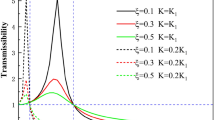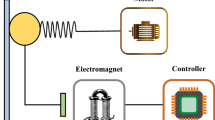Abstract
An electric-liquid active guide shoe is designed to aim at the problem of car horizontal vibration caused by guide unevenness excitation. Considering the imprecision of system dynamic modeling caused by the change of load during high-speed elevator operation and the nonlinear factors of active guide shoe, the Takagi-Sugeno (T-S) fuzzy reasoning method is adopted to approximate the nonlinear car system model. Further, taking the car acceleration, displacement and actuator saturation as the controlled performance indexes, an adaptive gain H∞ output feedback control strategy is proposed based on the parallel distributed compensation rule (PDC) to attenuate the horizontal vibration of the car system. To illustrate the effectiveness of the controller and its robustness to load changes, the acceleration time-frequency response of 4 m/s high-speed elevator car system under light load and heavy load was analyzed, and compared with the numerical results under H2/H∞ robust control, It is further verified that the proposed H∞ output feedback controller with adaptive gain can effectively suppress the horizontal vibration of the high-speed elevator car system.
Similar content being viewed by others
References
B. Z. Knezevic, B. Blanusa and D. P. Marcetic, A synergistic method for vibration suppression of an elevator mechatronic system, J. of Sound and Vibration, 406 (2017) 29–50.
Q. F. Peng, P. Xu and H. Yuan, Analysis of vibration monitoring data of flexible suspension lifting structure based on time-varying theory, Sensors, 20(22) (2020) 6586.
Q. Zhang, Z. Yang and C. Wang, Intelligent control of active shock absorber for high-speed elevator car, Proceedings of the Institution of Mechanical Engineers Part C-J. of Mechanical Engineering Science, 233(11) (2019) 3804–3815.
S. X. Cao, Q. He and R. J. Zhang, Active control strategy of high-speed elevator horizontal vibration based on LMI optimization, Control Engineering and Applied Informatics, 22(1) (2020) 72–83.
Y. H. Feng, J. W. Zhang and Y. Zhao, Modeling and robust control of horizontal vibrations for high-speed elevator, J. of Vibration and Control, 15(9) (2009) 1375–1396.
D. R. Santo, J. M. Balthazar and A. M. Tusset, On nonlinear horizontal dynamics and vibrations control for high-speed elevators, J. of Vibration and Control, 24(5) (2016) 825–838.
N. Mutoh, K. Kagomiya and T. Kurosawa, Horizontal vibration suppression method suitable for super-high-speed elevators, Electrical Engineering in Japan, 129(1) (2015) 59–73.
L. Qiu, Z. Wang and S. Zhang, A vibration-related design parameter optimization method for high-speed elevator horizontal vibration reduction, Shock and Vibration (2020) 1–20.
C. Chen, J. Q. Xu and G. B. Lin, Fuzzy adaptive control particle swarm optimization based on T-S fuzzy model of maglev vehicle suspension system, Journal of Mechanical Science and Technology, 34(1) (2020) 43–54.
S. B. Wang, Study on fuzzy-dmc control system of T-S fuzzy model, International Conference on Robotics and Automation Sciences (ICRAS) (2017) 94–97.
X. S. Li, X. H. Yuan and M. Z. Jiang, Fuzzy inference modeling method based on T-S fuzzy system, J. of Intelligent and Fuzzy Systems, 31(2) (2016) 727–736.
Z. X. Zhang, H. Y. Li and C. W. Wu, Finite frequency fuzzy H∞ control for uncertain active suspension systems with sensor failure, IEEE/CAA J. of Automatica Sinica, 5(4) (2018) 777–786.
H. Y. Li, J. Y. Yu and C. Hilton, Adaptive sliding-mode control for nonlinear active suspension vehicle systems using T-S fuzzy approach, IEEE Transactions on Industrial Electronics, 60(8) (2013) 3328–3338.
J. Liu, Y. Cui, H. Song, X. Zhang and Y. Qu, Stability analysis of T-S fuzzy-model-based coupled control systems with nonlinear T-S fuzzy control and its application, Neural Computing and Applications, 33 (2021) 15481–15493.
G. Wang, R. Jia and H. D. Song, Stabilization of unknown nonlinear systems with T-S fuzzy model and dynamic delay partition, J. of Intelligent and Fuzzy Systems, 35(2) (2021) 2079–2090.
Y. Wan, H. L. Huang and J. Tian, Dynamic self-adaptive reliability control for electric-hydraulic systems, Advances in Mechanical Engineering, 7(2) (2015) 767401.
A. Alleyne and L. Rui, A simplified approach to force control for electric-liquid systems, Control Engineering Practice, 8(12) (2015) 1347–1356.
L. Wang and H. K. Lam, New stability criterion for continuous-time Takagi-Sugeno fuzzy systems with time-varying delay, IEEE Transactions on Cybernetics (2018) 1–6.
R. R. Duan, J. M. Li and Y. N. Zhang, Stability analysis and H-infinity control of discrete T-S fuzzy hyperbolic systems, International J. of Applied Mathematics and Computer Science, 26(1) (2016) 133–145.
W. F. Li, Z. C. Xie and J. Zhao, Fuzzy finite-frequency output feedback control for nonlinear active suspension systems with time delay and output constraints, Mechanical Systems and Signal Processing, 132 (2019) 315–334.
H. D. Choi, C. K. Ahn and P. Shi, Dynamic output-feedback dissipative control for T-S fuzzy systems with time-varying input delay and output constraints, IEEE Transactions on Fuzzy Systems, 25(3) (2016) 511–526.
A. R. Luzi, D. Peaucelle and J. M. Biannic, Structured adaptive attitude control of a satellite, International J. of Adaptive Control and Signal Processing, 28(7–8) (2014) 664–685.
C. Pittet, A. Luzi, D. Peaucelle, J. M. Biannic and J. Mignot, In flight results of adaptive attitude control law for a microsatellite, CEAS Space J., 7(2) (2015) 291–302.
Acknowledgements
This study was funded by the Shandong Province Natural Science Foundation, China (grant number ZR2021ME245), and the Shandong Province Natural Science Foundation, China (grant number ZR2021ME210). The authors sincerely thank the editors and reviewers for their insight and comments to further improve the quality of this manuscript.
Author information
Authors and Affiliations
Corresponding author
Additional information
Ruijun Zhang is currently a Professor in School of Mechanical and Electrical Engineering, Shandong Jianzhu University, Jinan. He is the author of six books and more than 90 articles. He received the B.S. degree in Mechanical Engineering from Shandong Jianzhu University, Jinan, in 1985, the M.S. degree in Mechanical Engineering from Harbin Institute of Technology, Harbin, in 1990, and the Ph.D. degree in Mechanical and Electronic Engineering form School of Automation, Beijing University of Posts and Telecommunications, China, in 2015. His research interests include multi-field coupling vibration theory, system dynamics and intelligent control.
Tian Qiu is currently pursuing the M.S. degree with School of Mechanical and Electrical Engineering, Shandong Jianzhu University, Jinan. He received the B.S. degree in Electronic and Information Engineering from Electrical and Electronic Engineering College, Shandong University of Technology, Zibo, in 2017. His current research interests include optimal control, adaptive control and intelligent control.
Chen Chen is currently pursuing the Ph.D. degree in Mechanical Engineering from Northeastern University, Shenyang. She received the B.S. degree in Mechanical Engineering from Shandong Jiaotong University, Jinan, in 2018, the M.S. degree in Mechanical Engineering from Shandong Jianzhu University in 2020. Her research interests include robust control and intelligent control.
Rights and permissions
About this article
Cite this article
Zhang, R., Qiu, T. & Chen, C. Adaptive gain H∞ output feedback control strategy for horizontal vibration of high-speed elevator car system based on T-S fuzzy model. J Mech Sci Technol 37, 919–929 (2023). https://doi.org/10.1007/s12206-023-0132-3
Received:
Revised:
Accepted:
Published:
Issue Date:
DOI: https://doi.org/10.1007/s12206-023-0132-3




